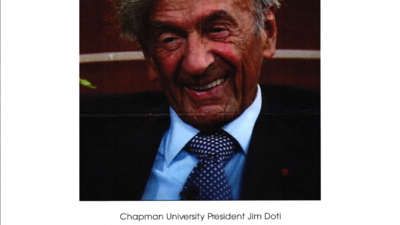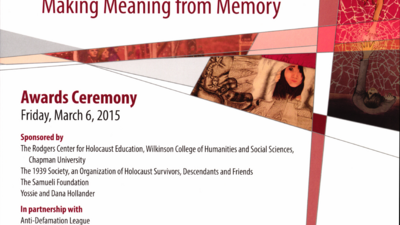Oral History Interview with Mina Kalter
Title
Date
Contributor
Summary
Mina Kalter, née Basseches, was born in 1921 in Przeworsk, Poland, into a religious family. Her father was a traveling merchant and her mother in retail fabrics. Both parents were active in Zionist organizations and charitable endeavors and on good terms with Christian neighbors, until 1939. She describes the extensive work of the Kehillah in helping those in need. She provides extensive detail of life after the German invasion of Poland in 1939: bombing and desecration of the synagogue, forced labor, confiscation of Jewish property, ghettoization of all Jews, the lack of any help by former Christian friends, ghetto conditions. She describes smuggling her small brother to the home of a loyal former family housekeeper and later her escape from a work detail in March 1941. She then crossed the River San to Soviet-controlled Poland where she was helped by a Russian Jewish family prior to being resettled in a small town near L’vov. She describes in detail life under Soviet rule in Poland. She was exiled to Siberia because she refused to accept Soviet citizenship. She describes her transport to and life in a labor camp for four years, until May 1945. She also relates her clandestine trip outside the Siberian camp to obtain potatoes for planting.
In March 1945, as a Polish citizen, she received by mail permission to return to Poland. Recently married, she describes working her way across Siberia toward Poland with her husband in June 1945, where she experienced antisemitism. Through the Joint Distribution Committee in Szczecin, she learned of the survival of her two brothers and joined them in a displaced persons camp in Berlin in August 1945. She describes in detail the living conditions with her new born baby. There is a brief mention of her stay at another camp near Landsberg in 1948. She and her family immigrated to the United States in 1950. She describes her adjustment in the U.S., her children’s awareness of their parents’ background, and their commitment to Judaism. She concludes with the hope that her testimony will remind future generations of the horrors of the Hitler years.
More Sources Like This
of
Hyman Blady
Hyman Blady was born February 11, 1920 in Warsaw to a middle class Zionist family; he belonged to HaShomer HaTzair. His father owned a shoe store. He discusses pre-war Poland, his education, and antisemitism in Poland.Hyman’s family was forced into the Warsaw Ghetto in 1939. A Christian friend helped him get some supplies out of his family’s shoe store to make shoes in the ghetto. Hyman also gives numerous of examples of Poles smuggling into the ghetto to buy Jewish wares at unreasonably low prices and describes how Jews managed to survive.
He escaped from the ghetto for a time passing as an Aryan, but returned to care for his younger brother when his mother died. Hegives a detailed description of the liquidation of the Warsaw Ghetto in 1942. After hiding in the ghetto, he and his brother are eventually found and sent to Bobruisk concentration camp for more than a year. Hyman worked as a shoemaker. His very young brother survived because a German soldier took pity on him when he was selected to die and made him his shoe polisher. Hyman worked as a shoemaker in several camps which he describes in detail. He and his brother were deported to Blizyn (for eight months), then Hyman was separated from his brother when he was deported to Plaszow (for six months) where he did saddlework. He describes the relatively improved conditions there.
In 1944, Hymanwas deported to Mauthausen and then theGusen subcamp where he worked underground building a factory for Messerschmidt airplanes for the Germans. He describes the deplorable conditions, selections, and scarcity of food. He details the horrible conditions during a deportation to get deloused in Linz, Austria. Many perished in a sealed cattle car and train cars were bombed by the Allies while there. Hyman describes being sent back to Gusen and then again to Mauthausen from which they were taken on a death march to Gunskirchen where they were scheduled to be killed. Hyman was liberated by Americans May 4 or 5, 1945. He and a group of boys went to a farm not far from Wels. He got ill eating too much food too quickly and was taken to a hospital in Lambach (Austria) for 2 weeks, but insisted on returning to his eight friends. After a time all refugees were forced to a DP camp near Wels. Subsequently, they travelled to Föhrenwald DP camp and he was eventually reunited with his brother who had survived Auschwitz. Hyman married in 1946. After their planned emigration was delayed because of the Exodus, they stayed in Germany, had a son, eventually emigrating to the United States sometime before 1950. Hyman attributes his survival to his sheer will to live and luck.
of
Arthur Stern
Arthur Stern served in Company E, 232nd Infantry, 42nd Division, U.S. 7th Army, during World War II. He relates a very brief encounter with a Jewish couple in hiding who were passing as Poles and had escaped from a work camp. He entered Dachau concentration camp on April 27th or 28th, 1945 to relieve another division. He was assigned to guard the women's area, then the gas chambers, until his unit left the following day.
He talked to some of the women in Yiddish and describes the physical and emotional state of the survivors. He was very impressed by an 18 year old girl he met there. She was from a well-to-do Czechoslovakian family, and despite her youth led and supported the other women. She told him how she managed to survive physically and spiritually.
He vividly describes his impressions when he entered the gas chambers and saw piles of bodies. Other soldiers told him about seeing box cars loaded with bodies and some survivors left to die by the Germans. He mentions why he can't believe that citizens of Munich didn't know what was going on in Dachau. He was part of the Army of Occupation e HHe in Austria after leaving the concentration camp.
Mr. Stern explains how he dealt with almost losing his faith in G'd after seeing the atrocities at Dachau. He feels that one redeeming factor were the few good people who helped. His own aunt and uncle, who lived in France, were hidden by French farmers, and their two children were sheltered in a convent.
Interviewee: STERN, Arthur Date: May 15, 1990
of
Leo Awin
Leo Awin was born in Vienna, Austria, in 1919 into a traditional Jewish home. His parents were born in parts of the Austro-Hungarian Empire that later became Romania and Poland. He grew up in the jewelry trade. After Kristallnacht, he helped at the Kultusgemeinde in Vienna, processing emigration papers for Jews. The family emigrated to Shanghai, going to Genoa, Italy by train then to Shanghai via the Suez Canal on the SS Victoria in May 1939.
The American Joint Distribution Committee helped the Awins and other Jewish refugees to settle in the Hongkew District of Shanghai. He describes Shanghai under Japanese occupation, including cultural life and relations among Jewish refugees of different nationalities in the International Settlement. He found work as a jeweler, first with Jewish immigrants and later worked clandestinely for a German jeweler. Polish refugees arrived by Trans-Siberian Railroad via Japan in 1942 or 1943. He married in 1947. At the end of the war Canada passed a special bill to admit Jewish refugees with Austrian passports as craftsmen. The Awins left Shanghai when 400 families, about 600-700 people, left in 1949 in four transport planes sent especially for them from Tokyo by the U.S. Air Force due to a special request by the Joint Distribution Committee. They left on short notice as the Communist forces closed in on the Shanghai airport. The remaining refugees left Shanghai during the next six months. He describes the cruelty of the Japanese towards the Chinese population and the comparatively easy treatment of Westerners by their soldiers. His transport arrived in Canada via Tokyo, and the Awin family settled permanently in Canada.
Recorded at the Rickshaw Reunion - a meeting in October 1991 at the Hilton Hotel in Philadelphia of refugees who found refuge in Shanghai during World War II.

This document is a promotional flyer announcing a television program titled "Dialogue with Doti." The program features Chapman University President Jim Doti in conversation with Elie Wiesel, a prolific author, Nobel Peace Prize recipient, and renowned Holocaust scholar. The flyer indicates that the program will air "TONIGHT AT 8:30 PM" and directs viewers to "WWW.KCET.ORG/DIALOGUEWITHDOTI" for more information. The bottom of the flyer prominently displays the logos for Chapman University and KCET, the latter celebrating "50 YEARS INSPIRING A BETTER STATE."
of
Zenek Maor
Zenek Maor, was born August 9, 1923, in Wloclawek, Poland, into a religious Jewish family. His father was a factory owner and the family lived comfortably until the German occupation. He details pre-war life including his HashomerHatzairactivities. He describes German restrictions and brutalities in Wloclawek, where his father was arrested and held for ransom, and later in Warsaw, where his family fled in January 1940. As a 16 year-old, he worked in various forced labor brigades, including the Okecie air-field in Warsaw. He gives detailed descriptions of life in the Warsaw ghetto including Jewish police and the HashomerHatzairnetwork of underground schools. Because of severe hunger in the ghetto, he was encouraged by his family to escape in 1942.
Eventually sent to various labor camps, he details difficult work conditions but mentions ongoing belief in his own survival. He discusses reasons that people could not escape from labor camps or from Auschwitz. He details his arrival at Auschwitz in summer 1943 including initial belief in the slogan “Work Makes You Free,” the smell of roasting flesh, and his defiance of Mengele’s decision to send him to annihilation with other children instead of assigning him to work with his older brother. Much information is given on Auschwitz: daily routine, work, treatment by Kapos, latrine communication between prisoners. He describes the death march from Auschwitz from January 17, 1945 to May 10, 1945 and gives an in-depth account of his liberation by the Russian Army. Returning to Poland, he learns that no one from his family survived. He emigrated to Palestine in April, 1947.
This interview was conducted in Haifa, Israel.

This document is a program for the 16th Annual Holocaust Art & Writing Contest, an event presented by Chapman University and The 1939 Society, with its awards ceremony held on March 6, 2015. The program details the contest's theme, "From Discovery to Action: Making Meaning from Memory," and acknowledges various sponsors, partners, and individuals involved as speakers and judges. It also includes information on a related "Evening of Holocaust Remembrance" held on April 16, 2015, which commemorated the 70th Anniversary of Liberation. A significant portion of the program features student artwork and a detailed biography of Holocaust survivor Jack Pariser, highlighting his remarkable story of survival during the Holocaust. Additionally, the program lists the numerous middle and high schools from across the United States and one from China that participated in the contest. The document serves as a comprehensive record of the event, its participants, and its educational mission.